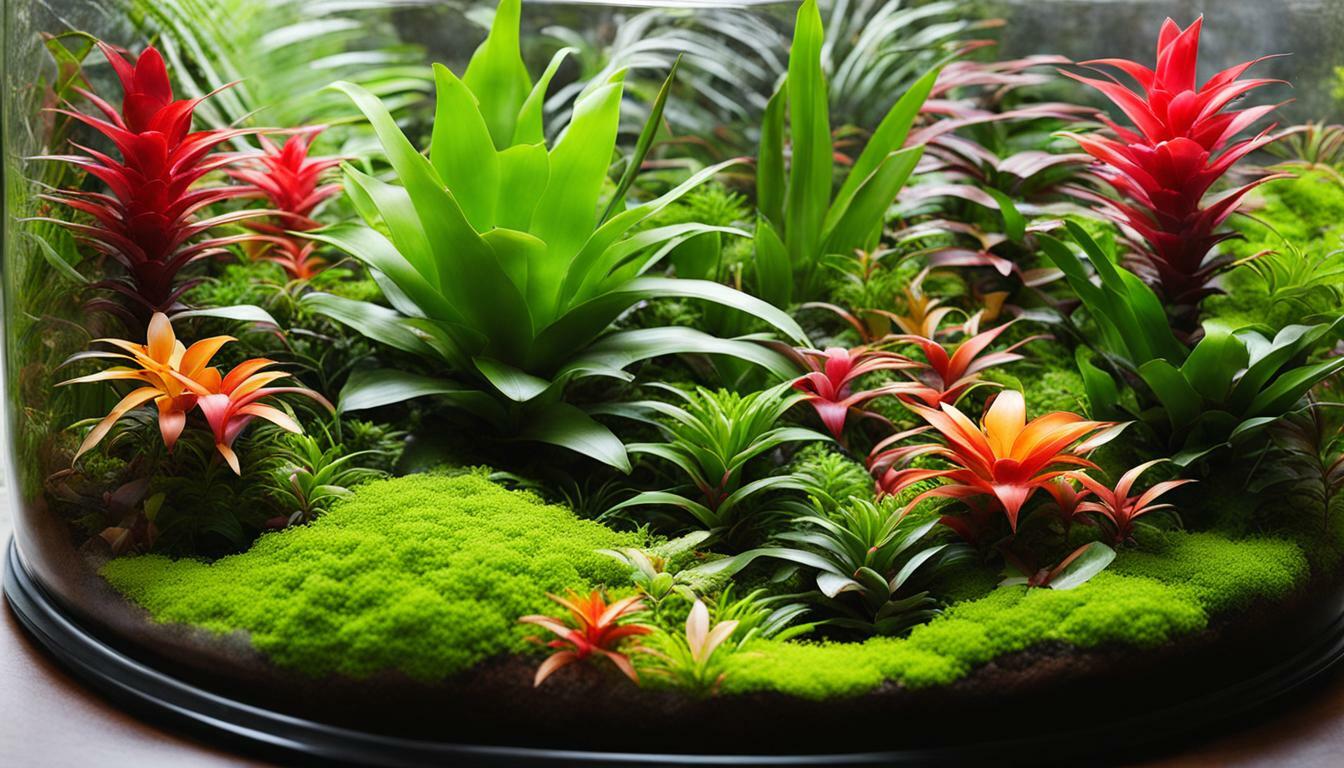Welcome to our comprehensive guide on terrarium plants bromeliads, where we will explore the best practices for incorporating these stunning plants into your indoor garden. Bromeliads are the perfect choice for terrariums, thanks to their love for humidity and small root systems. In this guide, we will cover everything you need to know about selecting the right terrarium, creating an ideal environment, and caring for your bromeliads to ensure their health and vibrancy.
- Choose open or vented terrariums for bromeliads
- Provide high humidity and bright indirect light
- Popular bromeliad species: Neoregelias, Cryptanthus, Aechmea, Vriseas, Bilbergia, and Tillandsia
- Water using rainwater or treated tap water and keep the central “cup” filled with water
- Place terrariums in warm, well-lit areas and increase humidity with misting or gravel trays
With the proper care and attention, your terrarium plants bromeliads will thrive and bring a touch of tropical beauty to your indoor garden. Let’s dive into the wonderful world of terrarium gardening with bromeliads!
Understanding Terrariums: Types and Setups
Before diving into the world of terrarium plants bromeliads, let’s explore the various types of terrariums and the key elements necessary for creating an optimal setup. Terrariums are enclosed glass containers that create a miniature ecosystem, providing a controlled environment for plants to thrive. When it comes to growing bromeliads in terrariums, there are a few important factors to consider.
Types of Terrariums: There are two main types of terrariums that are suitable for growing bromeliads: open and vented terrariums. Open terrariums have no lid and provide excellent airflow, making them ideal for bromeliads that prefer drier conditions. Vented terrariums, on the other hand, have a lid or vents that allow for better humidity control, which is essential for bromeliads that thrive in higher humidity.
Key Elements: Creating an optimal terrarium setup for bromeliads requires attention to a few key elements. First, choose a terrarium container that is large enough to accommodate the size of the plants and has good drainage. Next, select the right substrate, such as a well-draining potting mix or a mix of sphagnum moss and orchid bark. This will provide the necessary support and help maintain proper moisture levels. Additionally, consider the lighting requirements of your bromeliads. While they prefer bright indirect light, direct sunlight can scorch their leaves. Finally, monitor and maintain proper humidity levels by misting the leaves or placing the terrarium on a tray of moist gravel.
Table: Ideal Terrarium Setup for Bromeliads
| Aspect | Details |
|---|---|
| Container | Open or vented terrarium with good drainage |
| Substrate | Well-draining potting mix or sphagnum moss and orchid bark mix |
| Lighting | Bright indirect light, avoid direct sunlight |
| Humidity | Mist leaves or place on a tray of moist gravel |
By understanding the different types of terrariums and creating an optimal setup, you can provide the perfect environment for your bromeliads to thrive. In the next section, we will explore the various bromeliad species that are well-suited for terrariums and their care requirements.
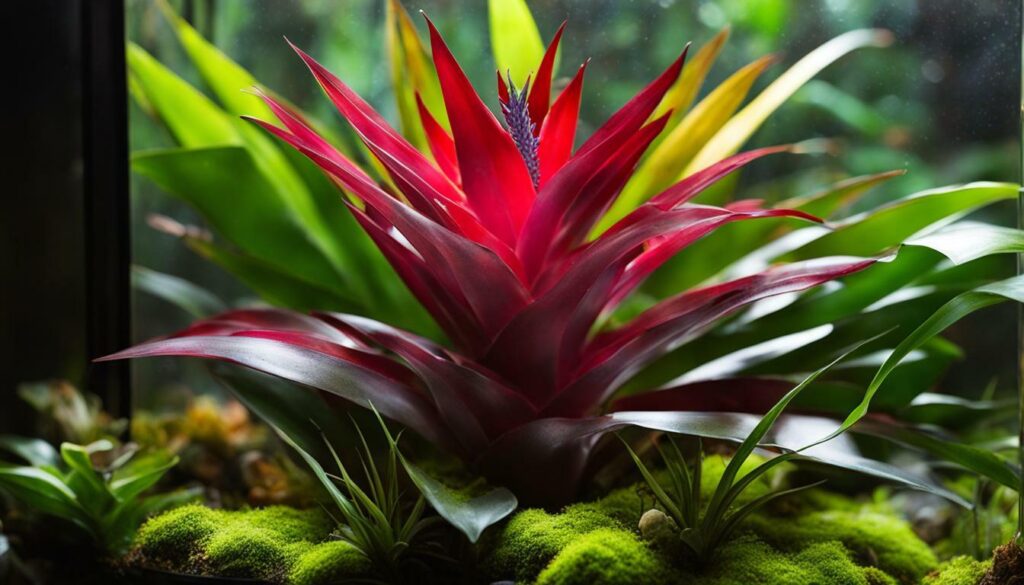
With numerous bromeliad species available, it’s essential to choose ones that thrive in the controlled environment of a terrarium. Let’s explore popular bromeliad species that are well-suited for these enclosed spaces.
| Bromeliad Species | Characteristics | Care Requirements |
|---|---|---|
| Neoregelias | Colorful foliage with vibrant patterns | Medium to bright indirect light, high humidity, well-draining soil |
| Cryptanthus | Compact, rosette-shaped plants with colorful leaves | Low to medium light, moderate humidity, well-aerated soil |
| Aechmea | Tall and elegant plants with long-lasting flowers | Bright indirect light, high humidity, well-draining soil |
| Vriseas | Star-shaped clusters of colorful flowers | Bright indirect light, moderate humidity, well-draining soil |
| Bilbergia | Spike-like blooms with vibrant colors | Bright indirect light, high humidity, well-draining soil |
| Tillandsia | Air plants that don’t require soil | Bright indirect light, occasional misting or soaking |
Each of these bromeliad species has its own unique characteristics and care requirements. When selecting bromeliads for your terrarium, it’s important to consider the overall environment and choose species that have similar needs. This will ensure that all the plants in the terrarium can thrive together.
Remember to provide the right amount of light, humidity, and well-draining soil for your chosen bromeliads. By selecting the right species, you can create a stunning terrarium display that will bring beauty and tranquility to any indoor space.
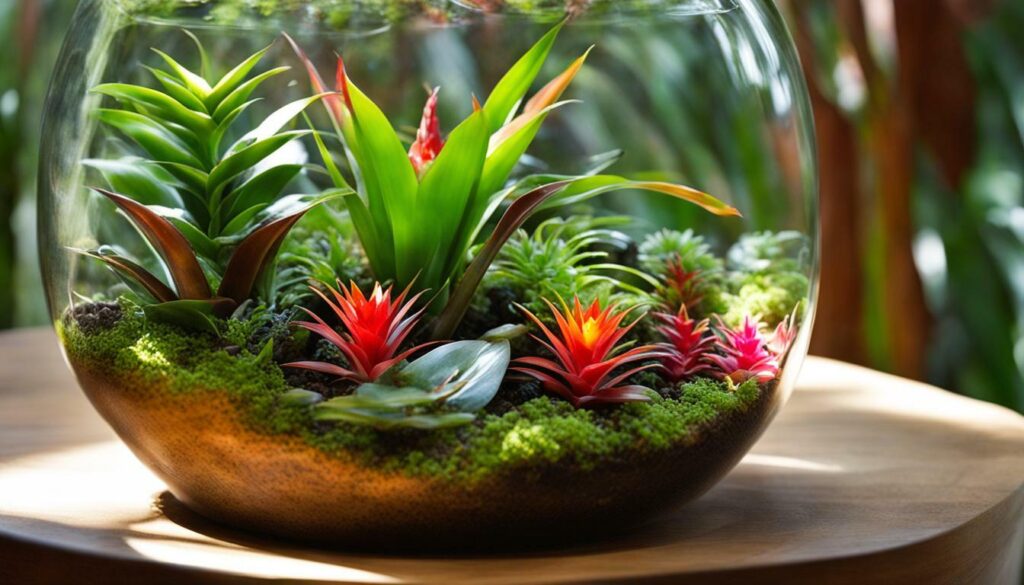
Caring for Bromeliads in a Terrarium
Proper care is crucial for the successful growth and longevity of bromeliads within a terrarium. Let’s explore the key aspects of caring for these fascinating plants in an enclosed environment.
Bromeliads are tropical plants that thrive in high humidity environments, making them excellent candidates for terrariums. When selecting bromeliads for your terrarium, it’s important to consider their specific care needs, as well as the needs of other plants in the terrarium. Some suitable bromeliads for terrariums include Neoregelias, Cryptanthus, Aechmea, Vriseas, Bilbergia, and Tillandsia.
One of the most important aspects of caring for bromeliads in a terrarium is maintaining proper watering and humidity levels. It’s recommended to water bromeliads with rainwater or treated tap water, as they are sensitive to chemicals in tap water. The central “cup” of the bromeliad should be kept approximately 1/4 to 1/2 full of water, ensuring it doesn’t overflow. This provides the necessary humidity for the plant. To increase humidity levels within the terrarium, misting the leaves or placing the terrarium on a tray of moist gravel can be effective.
Bromeliads also require bright indirect light to thrive. Place the terrarium in a warm room with plenty of natural light or use artificial grow lights if natural light is limited. Avoid placing the terrarium in direct sunlight, as it can cause the leaves to scorch. Monitor the lighting conditions and adjust accordingly to ensure the plants receive adequate light.
Regular maintenance is essential to keep your bromeliads healthy. Avoid overwatering, as this can lead to root rot. It’s also important not to over-fertilize bromeliads, as they are not heavy feeders. Use a balanced fertilizer specifically formulated for bromeliads, following the instructions on the package. Additionally, keep an eye out for common pests such as mealybugs, scale, and spider mites. These can be controlled by wiping them off with a damp cloth or increasing humidity to deter infestations.
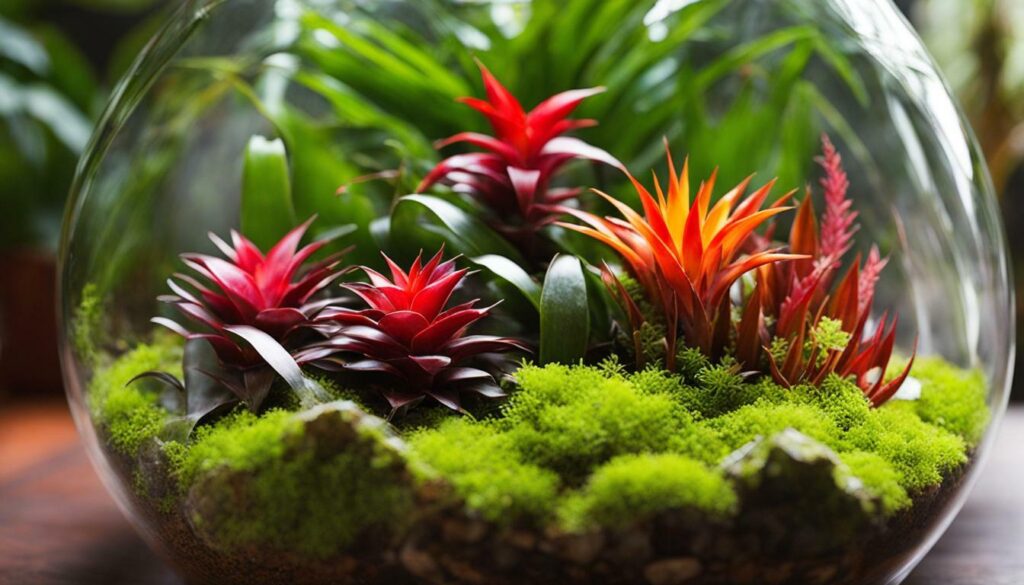
| Key Care Points | Tips |
|---|---|
| Watering | Use rainwater or treated tap water. Keep the central “cup” filled with water. |
| Humidity | Mist the leaves or place the terrarium on a tray of moist gravel to increase humidity. |
| Lighting | Provide bright indirect light, avoiding direct sunlight. |
| Maintenance | Avoid overwatering and over-fertilizing. Watch out for pests and take appropriate measures. |
Watering and Humidity for Bromeliads in Terrariums
Watering and maintaining optimal humidity levels are critical for the health and well-being of bromeliads in terrariums. Let’s explore the best practices for watering and creating a humid environment.
Watering Bromeliads in Terrariums
When it comes to watering bromeliads in terrariums, it is important to strike the right balance. Overwatering can lead to root rot, while underwatering can cause the plants to wither and dry out. To ensure proper hydration, use rainwater or treated tap water. Avoid using softened or distilled water, as the lack of minerals can be detrimental to the plants’ health.
One key feature of bromeliads is their central “cup,” which holds water and acts as a natural reservoir. This cup should be kept about 1/4 to 1/2 full of water at all times. However, it is crucial not to let the water stagnate, as this can create a breeding ground for pests and diseases. Regularly flush out the cup and replace the water to maintain cleanliness.
Creating a Humid Environment
Bromeliads thrive in humid environments, mimicking their natural habitat in tropical regions. To increase humidity levels within the terrarium, mist the leaves regularly using a spray bottle. This will provide a fine mist that settles on the foliage and helps to recreate the moist conditions that bromeliads prefer.
Another method to boost humidity is by placing the terrarium on a tray of moist gravel. As the water in the tray evaporates, it raises the humidity level within the terrarium. Just make sure the bottom of the terrarium doesn’t come in direct contact with the water, as this can lead to root rot.
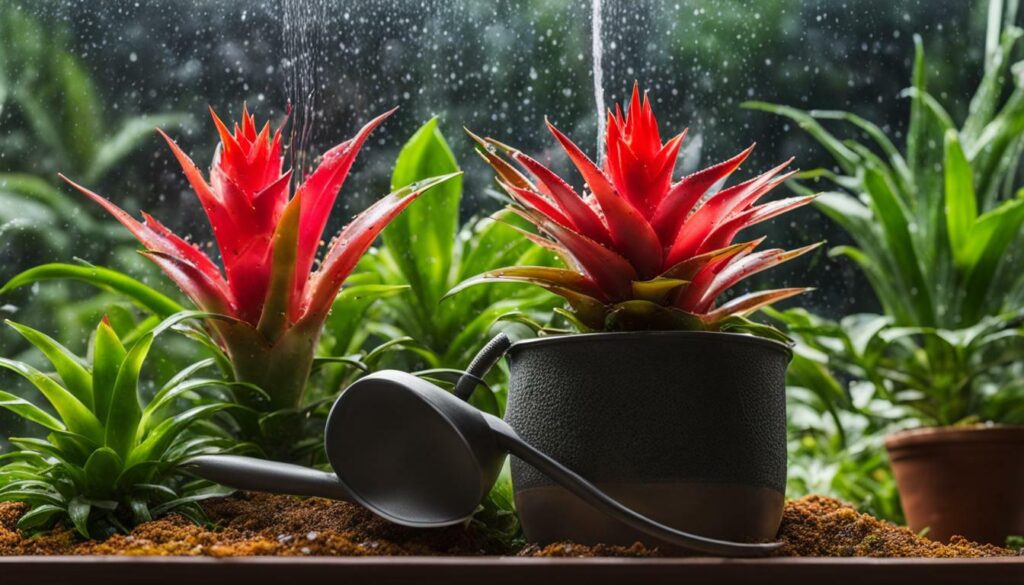
Watering and humidity are crucial aspects of caring for bromeliads in terrariums. Proper watering practices, such as using rainwater or treated tap water and filling the central cup to the appropriate level, ensure that bromeliads receive the right amount of hydration. Additionally, creating a humid environment through misting and the use of a moist gravel tray helps to replicate the tropical conditions these plants thrive in.
Placement and Lighting for Terrariums with Bromeliads
The correct placement and lighting conditions play a significant role in the growth and overall appearance of bromeliads in terrariums. Let’s explore the optimal environment for these plants to thrive.
Bromeliads, being tropical plants, require bright, indirect light to flourish. Placing the terrarium in a warm room with ample natural light is ideal. Avoid direct sunlight as it can scorch the leaves and cause damage. If natural light is limited, supplement it with artificial lighting using full-spectrum grow lights. These lights mimic the sun’s spectrum and provide the necessary light energy for photosynthesis.
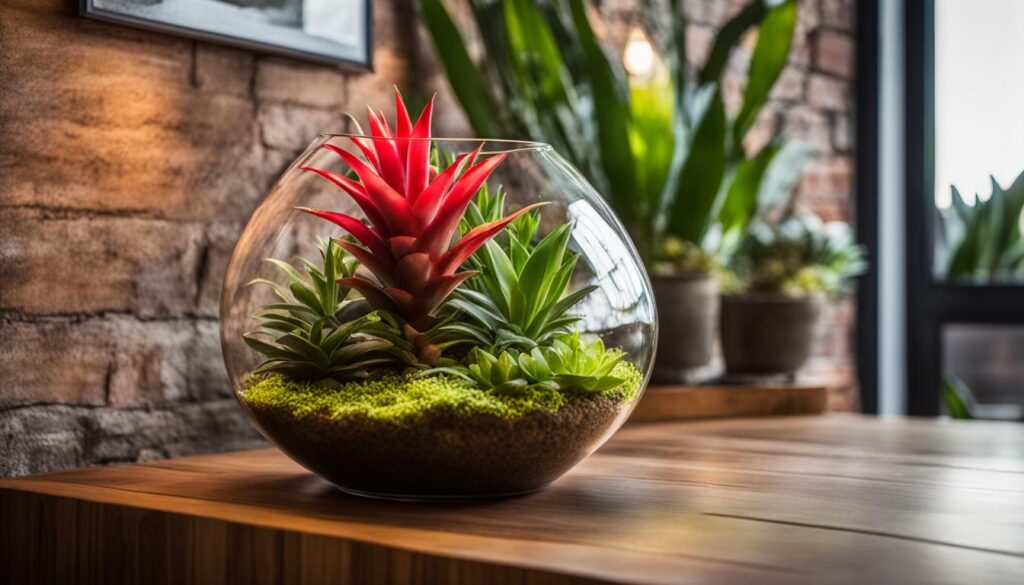
To ensure even light distribution, rotate the terrarium periodically. This will prevent the plants from leaning and reaching towards the light source, promoting balanced growth. If the terrarium has uneven lighting due to surrounding obstacles, consider using reflective materials such as mirrors or white walls to bounce light back onto the plants.
When designing your terrarium, consider the size and height of the bromeliads. Taller plants should be placed towards the back or middle, while shorter varieties can be positioned closer to the front. This arrangement will create depth and visual interest in your terrarium display.
Lighting Tips:
- Ensure the light source is at an appropriate distance from the plants to prevent burning or wilting.
- Rotate the terrarium every few weeks to ensure all sides receive equal exposure to light.
- Monitor the intensity of the light by observing the color and growth of the plants. Adjust the lighting accordingly.
| Bromeliad Species | Lighting Requirements | Placement |
|---|---|---|
| Neoregelias | Medium to bright indirect light | Mid to back of the terrarium |
| Cryptanthus | Bright indirect light | Front to midsection of the terrarium |
| Aechmea | Bright indirect light | Back of the terrarium |
| Vriseas | Bright indirect light | Mid to back of the terrarium |
| Bilbergia | Bright indirect light | Mid to back of the terrarium |
| Tillandsia | Bright indirect light | Can be mounted on decorative branches or placed in small containers |
“The right placement and lighting conditions are essential for bromeliads to thrive in terrariums. Provide bright indirect light and consider rotating the terrarium to ensure even exposure. The choice of bromeliad species and their placement within the terrarium will contribute to a visually appealing display.”
Propagating Bromeliads in Terrariums
Propagating bromeliads can be an exciting way to expand your terrarium collection. Let’s explore the process of propagating these captivating plants and acquiring new additions for your indoor garden.
One method of propagating bromeliads is by removing the pups, or baby plants, that grow at the base of the parent plant. These pups can be carefully separated from the parent plant using a sharp, sterile knife or scissors. It is important to ensure that each pup has some roots attached to it, as this will increase its chances of successfully establishing itself in a new container.
Once the pups have been removed, they can be potted up in small containers filled with a well-draining potting mix. It is recommended to use a mix specifically formulated for bromeliads or a mixture of orchid bark, perlite, and peat moss. Place the pup in the potting mix, ensuring that the roots are covered, and gently firm the mix around it. Water the pup lightly to settle the soil and provide some moisture.
| Potting Mix | Watering | Lighting |
|---|---|---|
| Well-draining potting mix | Lightly watered to settle the soil | Bright indirect light |
| Mixture of orchid bark, perlite, and peat moss |
Propagating bromeliads can be a rewarding process, allowing you to create a larger collection of these stunning plants. Remember to be patient, as it may take some time for the pups to establish themselves and produce their own colorful foliage and flowers. With proper care and attention, your bromeliad terrarium will continue to thrive and bring beauty to your indoor space.
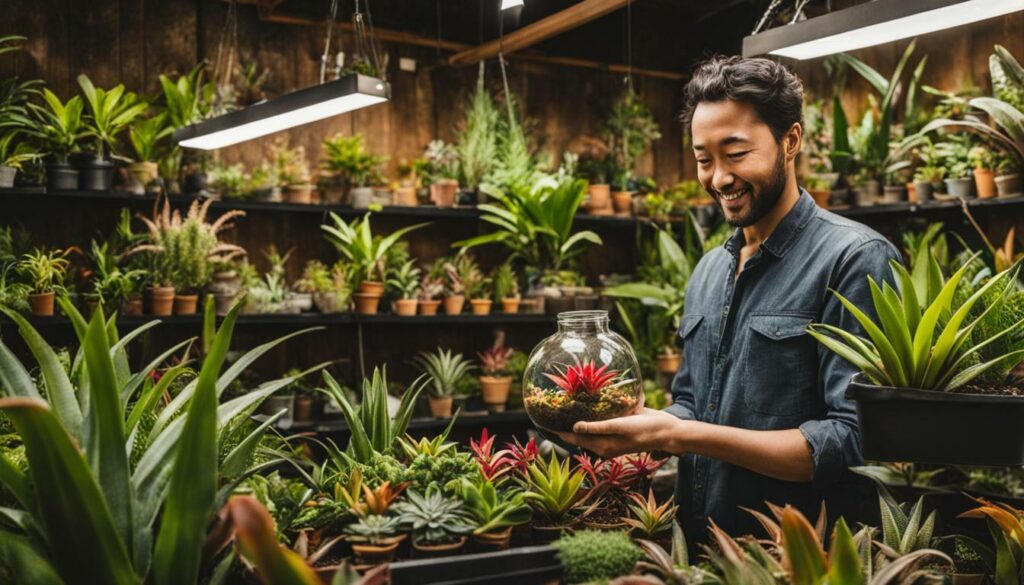
While bromeliads are generally resilient, they can still fall prey to pests within a terrarium. Let’s explore effective methods for preventing and managing common pests in bromeliad terrariums.
One of the most common pests that can affect bromeliads in terrariums is mealybugs. These small, white, cottony insects can quickly multiply and damage the plants. To control mealybugs, wipe them off the leaves and stems with a damp cloth. For severe infestations, consider using an insecticidal soap or neem oil spray.
Another troublesome pest is scale. These tiny, immobile insects attach themselves to the leaves and suck the sap from the plant. To eliminate scale, use a cotton swab dipped in rubbing alcohol and gently rub each individual insect. Repeat this process every few days until the infestation is under control.
Spider mites are yet another common pest that can affect bromeliads. These tiny arachnids suck the sap from the plant, causing yellowing leaves and webbing. To combat spider mites, regularly mist the leaves with water to increase humidity and wipe them off with a damp cloth. Additionally, you can introduce beneficial predators like ladybugs or predatory mites to control the population.
Preventing pests is always preferable to dealing with an infestation. Monitor your terrarium regularly for signs of pests and take action immediately if you spot any. Quarantine new plants before introducing them to your terrarium to ensure they are pest-free. Maintain a clean and well-ventilated growing environment, and avoid overwatering, as it can create a favorable environment for pests. By practicing good care habits and promptly addressing any pest issues, you can help your bromeliads thrive in their terrarium home.
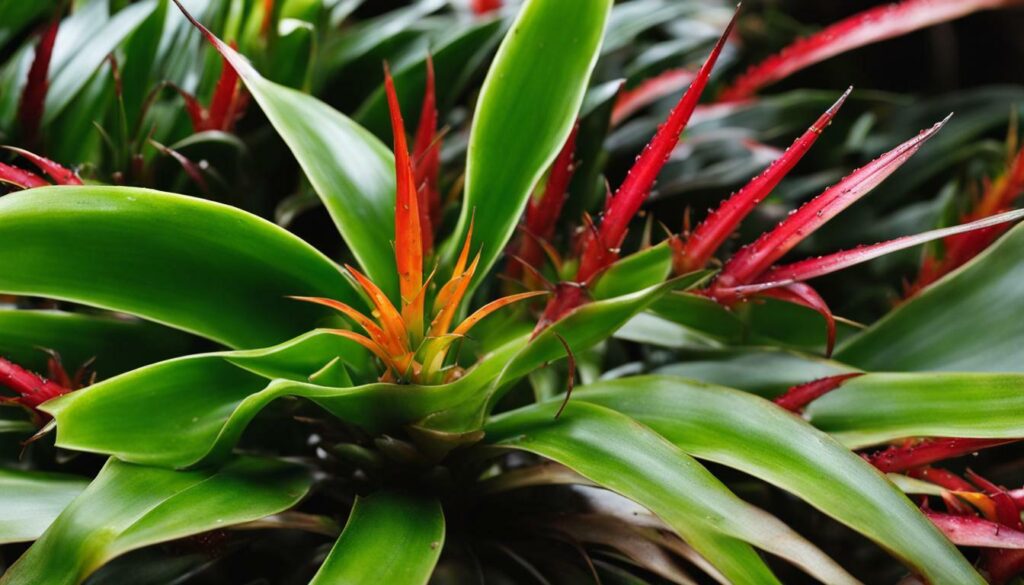
Caring for bromeliads in terrariums requires attention to detail, and even experienced gardeners can make mistakes. Let’s explore common pitfalls to avoid for successful bromeliad care in terrariums.
One common mistake is overwatering bromeliads. While they do enjoy high humidity, their small root systems are sensitive to excess moisture. It is important to water bromeliads judiciously, using rainwater or treated tap water. The central “cup” should be kept about 1/4 to 1/2 full of water, ensuring it doesn’t overflow. Overwatering can lead to root rot and other fungal diseases, which can be detrimental to the plant’s health.
Another mistake to avoid is placing the terrarium in a location with inadequate lighting. Bromeliads thrive in bright indirect light, so it is essential to provide them with sufficient illumination. Placing the terrarium in a warm room with plenty of natural light, but without direct sunlight, is ideal. If natural light is limited, supplemental grow lights can be used to ensure the plants receive the necessary light energy for growth.
| Common Mistakes to Avoid | Tips for Successful Bromeliad Care |
|---|---|
| Overwatering | Water judiciously using rainwater or treated tap water. Keep the central “cup” about 1/4 to 1/2 full of water. |
| Inadequate lighting | Place the terrarium in a warm room with bright indirect light. Supplemental grow lights can be used if natural light is limited. |
| Ignoring pests | Regularly inspect the plants for pests such as mealybugs, scale, and spider mites. Wipe them off with a damp cloth or increase humidity to deter infestations. |
| Over-fertilizing | Avoid excessive fertilization, as bromeliads are relatively low-maintenance plants. Use a balanced fertilizer at a diluted strength and follow the recommended dosage. |
Lastly, ignoring the presence of pests can lead to significant damage to bromeliads. Regularly inspect the plants for common pests such as mealybugs, scale, and spider mites. These pests can suck the sap from the plants, weakening them over time. If any pests are found, they should be promptly removed by wiping them off with a damp cloth. Increasing humidity levels within the terrarium can also help deter pests and prevent infestations.
By avoiding these common mistakes and providing the appropriate care, you can ensure the long-term health and vibrancy of your bromeliads in a terrarium. Take the time to understand their specific care requirements and create an ideal environment for them to thrive. With proper care, bromeliads can add beauty and a touch of tropical elegance to your indoor garden.
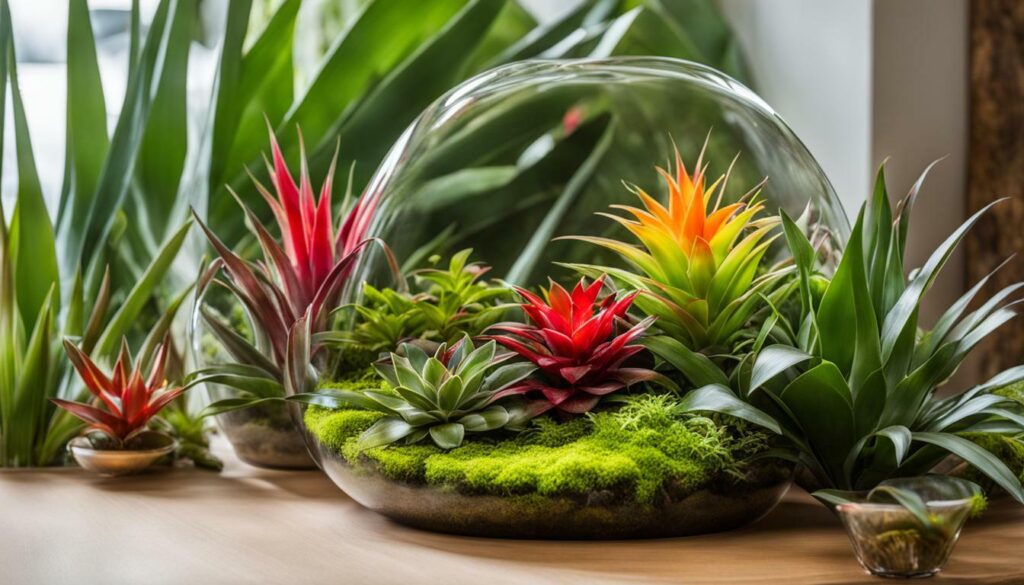
Incorporating terrarium plants bromeliads into your indoor garden can bring a host of benefits to your living space, transforming it into a lush and vibrant oasis. These exotic beauties not only add a touch of elegance to your home but also provide a tropical feel that can instantly uplift your mood.
Bromeliads are particularly well-suited for terrariums due to their love for humidity and small root systems. The controlled environment of a terrarium allows you to create the perfect conditions for these plants to thrive. With their vibrant foliage and unique shapes, bromeliads become the focal point of any indoor garden.
When selecting bromeliads for your terrarium, you have a variety of species to choose from. Neoregelias, Cryptanthus, Aechmea, Vriseas, Bilbergia, and Tillandsia are some popular bromeliads that are suitable for terrariums. These species come in a range of colors and sizes, allowing you to create a diverse and visually appealing display in your terrarium.
In addition to their aesthetic appeal, bromeliads are low-maintenance plants. They require minimal watering and can thrive in bright indirect light. With the right care, these resilient plants can bring beauty and life to your indoor garden for years to come.
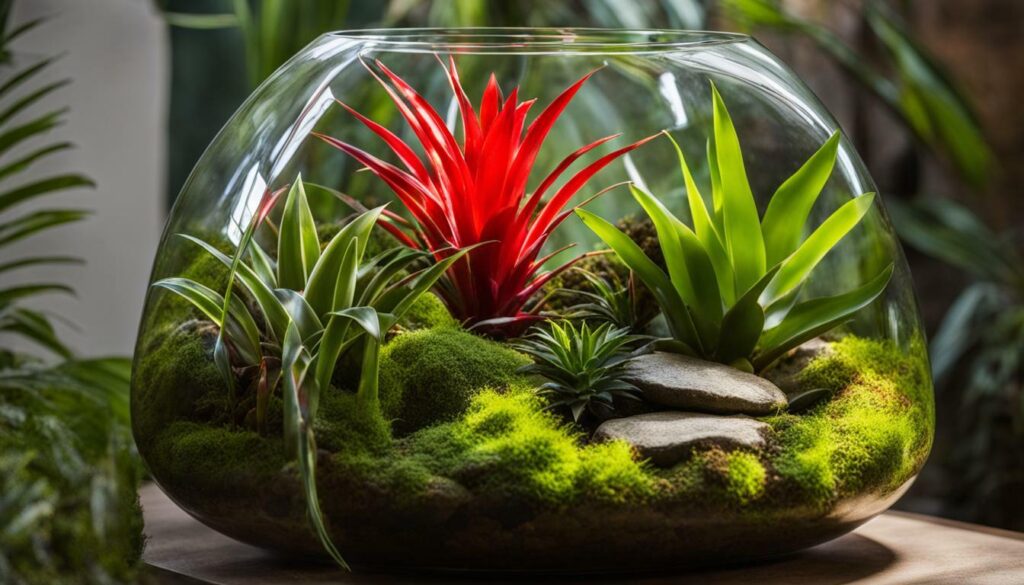
- Add a touch of elegance and a tropical feel to your indoor garden.
- Low-maintenance plants that require minimal watering.
- Thrives in bright indirect light, making them suitable for various locations within your home.
- Wide variety of species to choose from, allowing for diverse and visually appealing displays.
- Transforms your living space into a lush and vibrant oasis.
With their beauty, ease of care, and ability to thrive in a terrarium environment, terrarium plants bromeliads are an excellent choice for any indoor garden enthusiast. Whether you’re an experienced gardener or just starting your gardening journey, these captivating plants are sure to bring joy and tranquility to your home.
Maintaining and Enjoying your Terrarium Plants Bromeliads
Once your terrarium plants bromeliads are established, it’s time to settle into a routine that ensures their continued health and enjoyment. These exotic beauties require specific care to thrive in a terrarium environment, but with the right strategies, you can enjoy their vibrant colors and unique shapes for years to come.
1. Consistent watering: Bromeliads have a unique way of absorbing water through their leaves, which means they don’t rely heavily on their roots. It’s important to keep the central “cup” of the plant filled with water, but be careful not to overwater. Aim to keep the cup about 1/4 to 1/2 full, and use rainwater or treated tap water to prevent mineral buildup.
2. Ideal placement: Terrariums with bromeliads should be placed in a warm room with bright indirect light. They thrive in temperatures between 60-80°F (15-27°C). Avoid placing them in direct sunlight, as it can burn their leaves. If you notice elongation of leaves, it may be an indication that the plants are not getting enough light.
3. Maintaining humidity: Bromeliads love humidity, and it’s essential to maintain high levels within the terrarium. You can increase humidity by misting the leaves regularly or placing the terrarium on a tray of moist gravel. This will help replicate their natural tropical environment and promote optimal growth.
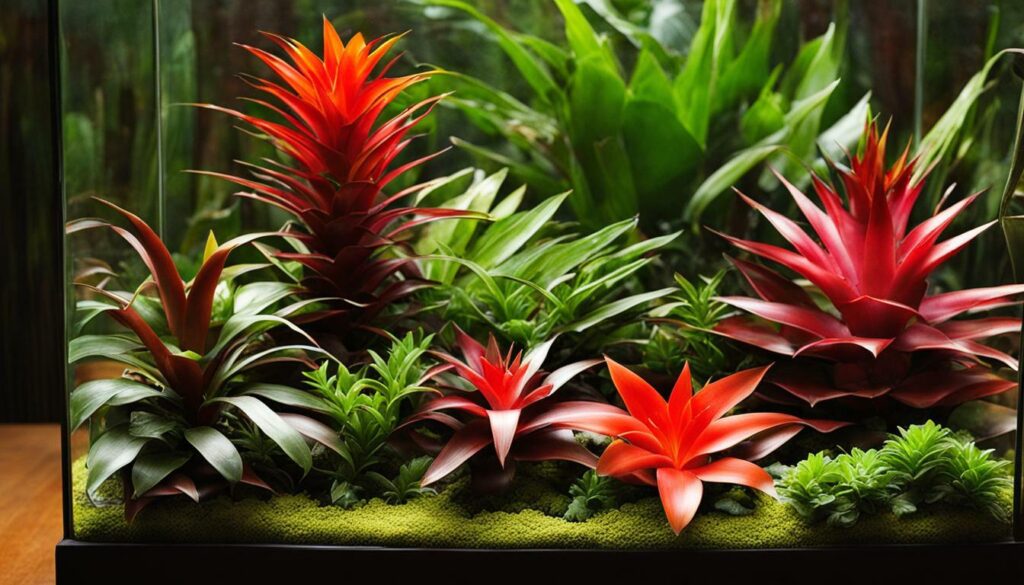
“To enjoy the full beauty of your terrarium plants bromeliads, it’s important to regularly remove any dead leaves or spent flowers. This not only keeps your terrarium looking tidy but also helps prevent the spread of disease.” – Horticulture Expert
By following these care tips, you can create a thriving and visually appealing terrarium filled with stunning bromeliads. Take the time to observe your plants’ growth and make adjustments to their care routine as needed. With proper maintenance, your terrarium will become a captivating centerpiece and a source of joy in your indoor garden.
Conclusion
Congratulations! You now have a comprehensive understanding of terrarium plants bromeliads and how to incorporate these stunning plants into your indoor garden. With their love for humidity and small root systems, bromeliads are an excellent choice for terrariums. By selecting the right terrarium, creating an ideal environment, and providing proper care, you can enjoy the beauty and uniqueness of these captivating plants.
When choosing bromeliads for your terrarium, consider species like Neoregelias, Cryptanthus, Aechmea, Vriseas, Bilbergia, and Tillandsia. These species have unique characteristics and care requirements that make them suitable for terrariums. Remember to consider the needs of all the plants in the terrarium to ensure compatibility.
To maintain the health and vibrancy of your bromeliads, provide them with the right watering and humidity levels. Water them using rainwater or treated tap water, and be sure to keep the central “cup” filled with the appropriate amount of water. Additionally, place your terrarium in a warm room with bright indirect light, and consider misting the leaves or using a tray of moist gravel to increase humidity levels.
Propagation is another way to expand your bromeliad collection. Look for pups, or baby plants, that grow at the base of the parent plant. You can remove these pups and pot them up for further growth. Just remember to avoid overwatering or using too much fertilizer as bromeliads prefer a more moderate approach to care.
Lastly, be mindful of common pests that can affect bromeliads in terrariums, such as mealybugs, scale, and spider mites. Regularly inspect your plants and take steps to control these pests, such as wiping them off with a damp cloth or increasing humidity levels to deter infestations.
With your newfound knowledge and care, you can now create a stunning terrarium with terrarium plants bromeliads that will enhance the ambiance of your indoor garden. Enjoy the beauty and vibrancy of these exotic plants as they thrive in their ideal terrarium environment.
Can Bromeliads be Used in Aquatic Terrariums for Indoor Gardens?
Yes, bromeliads can be used in aquatic terrariums for indoor gardens. These unique plants thrive in a terrarium environment and can add a pop of color and texture. When placed in a terrarium alongside other aquatic plants, bromeliads can create a lush, tropical oasis right in your home.
FAQ
Can all bromeliads be grown in terrariums?
No, not all bromeliads are suited for terrariums. Some bromeliads require more space and air circulation than a terrarium can provide. It is important to choose bromeliad species that have small root systems and can tolerate high humidity.
How often should I water bromeliads in a terrarium?
Bromeliads in terrariums should be watered when the central “cup” is about 1/4 to 1/2 empty. It is recommended to use rainwater or treated tap water for watering. Avoid overwatering, as bromeliads can be susceptible to root rot.
How do I increase humidity in a terrarium for bromeliads?
You can increase humidity in a terrarium by misting the leaves of the bromeliads or placing the terrarium on a tray of moist gravel. This will create a microclimate of higher humidity around the plants.
How much light do bromeliads need in a terrarium?
Bromeliads in terrariums prefer bright indirect light. They should not be exposed to direct sunlight, as it can cause their leaves to burn. Place the terrarium in a warm room with plenty of natural light, but avoid direct sunlight.
Can I propagate bromeliads in a terrarium?
Yes, bromeliads can be propagated in a terrarium. You can remove the pups, or baby plants, that grow at the base of the parent plant and pot them up separately. This allows for the growth of new bromeliad plants.
How do I control pests in a terrarium with bromeliads?
If pests such as mealybugs, scale, or spider mites appear in the terrarium, you can wipe them off the leaves with a damp cloth. Increasing the humidity in the terrarium can also help deter pest infestations.
Can I fertilize bromeliads in a terrarium?
Bromeliads in a terrarium generally don’t require frequent fertilization. If you choose to fertilize, use a diluted liquid fertilizer specifically formulated for bromeliads and follow the instructions on the packaging. Avoid overfeeding, as it can harm the plants.

